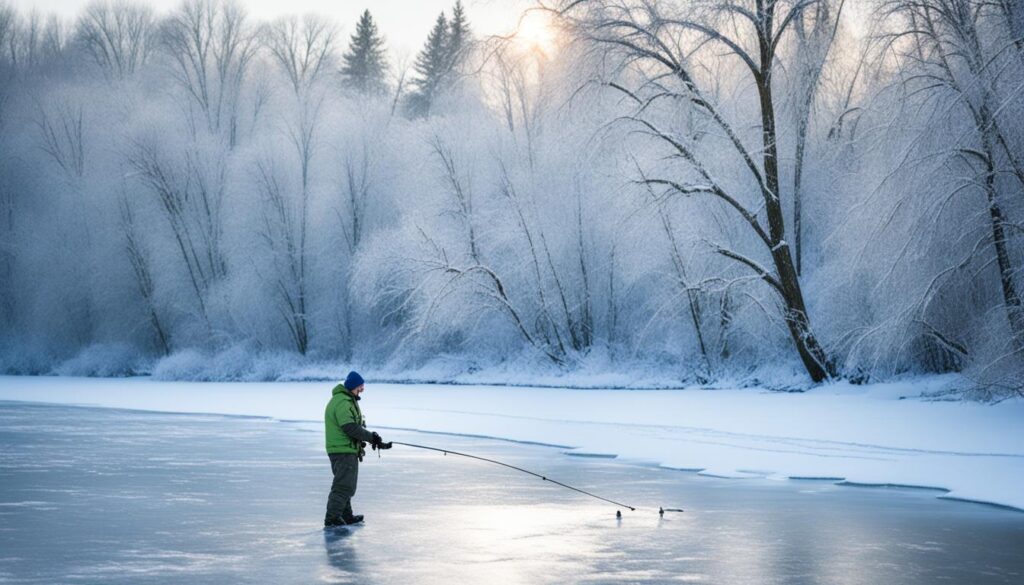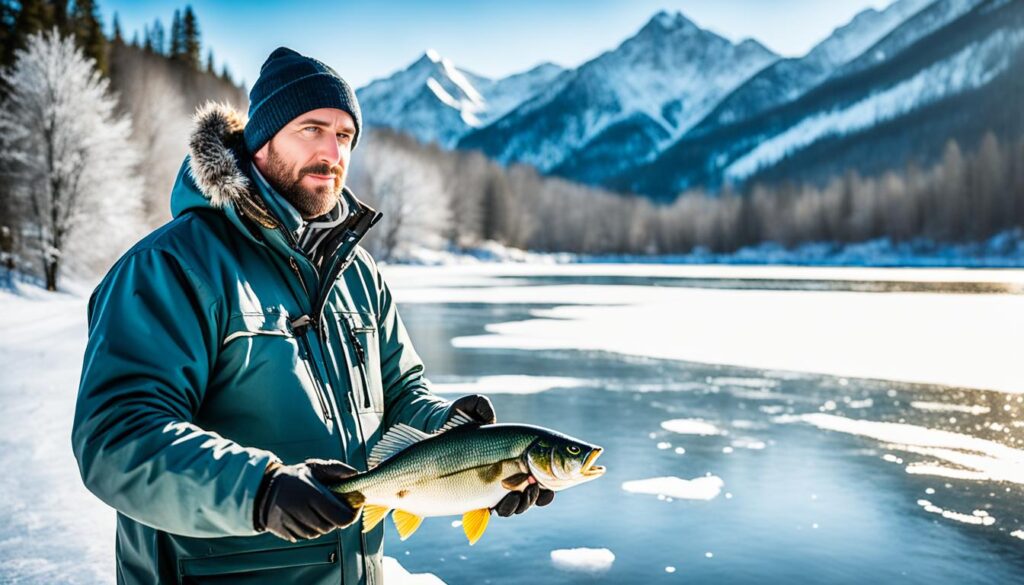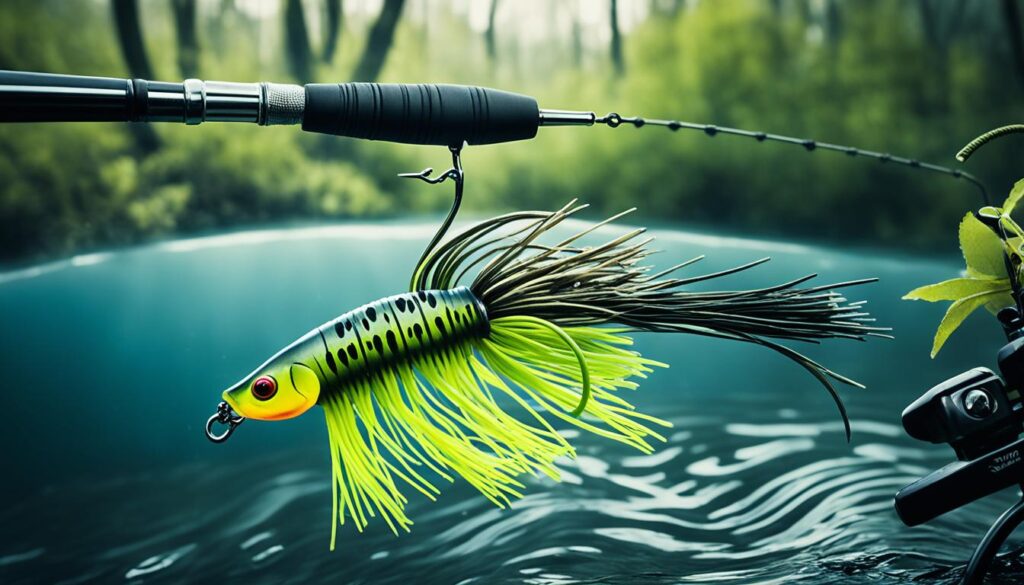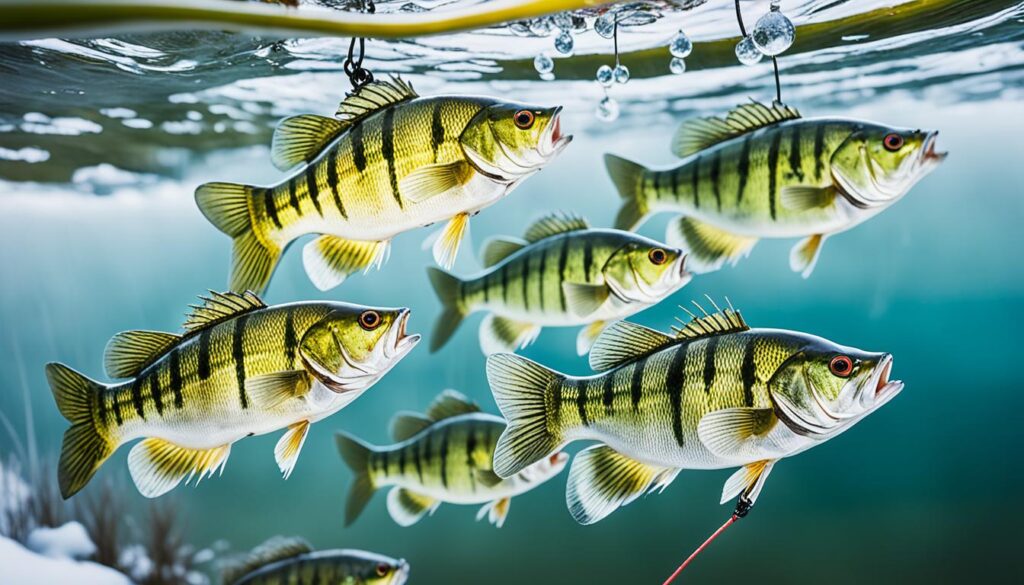When it comes to winter bass fishing, one technique stands out as particularly deadly: fishing with Chatterbaits. These versatile lures have proven time and time again to be highly effective at attracting and catching bass, even in the coldest months of the year.
Chatterbaits are weighted jig heads with a skirt and a large hexagonal blade that creates vibration and noise underwater. This unique combination of movement and sound is irresistible to bass, making Chatterbaits a powerful tool in your winter fishing arsenal.
Using Chatterbaits correctly is key to maximizing your success. They can be fished slowly, close to the bottom, or over cover like weed beds and fallen trees. When the water is dirty, or when bass are holding deep, Chatterbaits can be a game-changer.
Key Takeaways:
- Chatterbaits are highly effective at catching bass in the winter months.
- Their unique design and movement create vibration and noise to attract bass.
- Fishing Chatterbaits slowly and over cover can greatly increase your catch rate.
- Choosing the right gear, such as the Z Man Chatterbait, is essential for success.
- Chatterbaits can be used in various locations, including grassy areas and under docks, to target winter bass.
The Z Man Chatterbait – One of my favorite and most successful lures
When it comes to bass fishing, the Z Man Chatterbait is a top-performing lure that has earned a special place in my tackle box. Its unique design and action make it incredibly effective at attracting and enticing bass, especially during the winter months. Let’s take a closer look at why the Z Man Chatterbait is one of my go-to lures and how you can make the most of it in your winter bass fishing adventures.
The Versatility of the Z Man Chatterbait
The Z Man Chatterbait comes in various weights and can be paired with different trailers, allowing you to customize it according to your fishing conditions and target species. This versatility makes it suitable for different styles of fishing and water conditions. Whether you’re fishing in shallow grassy areas or deeper structures, the Z Man Chatterbait can adapt to various scenarios, making it a reliable choice for winter bass fishing.
Choosing the Right Color Chatterbait for Winter
Color selection plays a significant role in the success of chatterbait fishing, particularly in winter when bass tend to be more hesitant to strike. When selecting a chatterbait color for winter bass fishing, it’s best to go for natural and subtle hues that imitate the baitfish in the area. Popular color choices for winter include green pumpkin, shad, and black-blue patterns. These colors provide a realistic presentation that can help trigger strikes from wary bass in cold water.
Essential Winter Bass Fishing Gear
Having the right gear is essential for successful winter bass fishing with a Z Man Chatterbait. Here are some key gear considerations:
- Chatterbait weight: Opt for a 3/8 oz to 1 oz chatterbait for winter fishing, as this will allow you to fish at different depths and maintain better control over your lure.
- Rod and reel setup: Choose a medium to medium-heavy spinning or baitcasting rod paired with a high-quality reel. The rod should have a sensitive tip to detect subtle bites and enough power to handle bigger winter bass.
- Braided or fluorocarbon line: Use braided or fluorocarbon line with a suitable pound test to handle the strong strikes and retrieve challenges posed by winter bass.
With the right gear and the Z Man Chatterbait in your arsenal, you’ll be well-equipped to target winter bass and increase your chances of landing that trophy fish.
Fishing Chatterbaits Slowly – A Deadly Technique for Winter Bass
Fishing chatterbaits slowly is a highly effective technique for targeting bass in the winter season. By utilizing this method, anglers can increase their chances of success in cold weather conditions. When using this technique, precision and patience are key factors.
To implement this deadly technique, start by casting your chatterbait into areas that are likely to hold bass, such as rock piles or weed beds. Allow the bait to sink to the bottom before proceeding.

Once the chatterbait has settled on the bottom, begin working the bait by lifting and dropping your rod. This motion creates a rising and falling action, which mimics the movement of natural prey. The key is to keep the retrieve slow and steady, allowing the chatterbait’s blade to produce the enticing chattering noise and vibration that bass find irresistible. This combination of sound and motion helps to attract bass and trigger strikes.
Fishing chatterbaits slowly is particularly effective when targeting bass that are close to cover, as the slow retrieve gives fish ample time to strike. Rock piles, weed beds, and other forms of cover provide shelter for bass during the colder months, and the slow-moving chatterbait presents an excellent opportunity to entice them out of their hiding spots.
“Fishing chatterbaits slowly is like presenting a slow-moving meal to hungry winter bass. The bait’s unique design and vibration appeal to their instincts, making it hard for them to resist.”
By employing this deadly technique, anglers can capitalize on the winter bass’s ambushing behavior and increase their chances of landing a trophy-sized fish. Whether you’re a seasoned angler or a beginner, mastering the art of fishing chatterbaits slowly is a valuable skill to have in your winter bass fishing arsenal.
Winter Bass Fishing Strategies Checklist
Before heading out for your next winter bass fishing trip, keep the following strategies in mind:
- Cast chatterbaits near cover, such as rock piles or weed beds.
- Retrieve the chatterbait slowly, allowing it to create vibration and noise.
- Use a slow and steady motion to imitate natural prey.
- Experiment with different chatterbait colors to find what works best in your fishing location.
- Target areas where bass seek shelter, such as fallen trees or brush piles.
Fishing Chatterbaits Over Cover – Tempting Bass Out from Their Lairs
Fishing chatterbaits over cover, such as weed beds or under docks, can be a highly effective technique for targeting bass in cold weather. The strategic placement of your bait close to the cover increases the chances of tempting bass out from their hiding spots, leading to more successful catches.
When fishing chatterbaits over cover, it’s important to maintain a slow and steady retrieve. By keeping the chatterbait as close to the cover as possible, you create a realistic presentation that mimics the movements of natural prey. This slow approach increases the likelihood of triggering a bass’s predatory instincts.
If you find yourself snagging the weeds while retrieving, try slightly speeding up to avoid obstructions. On the other hand, if the chatterbait is riding too high in the water column, slow down to keep it within the bass’s strike zone. By making these subtle adjustments, you can optimize the performance of your chatterbait and increase your chances of enticing a strike.
The vibrating blade on the chatterbait creates noise and disturbance in the water, mimicking the movements of injured baitfish. This attracts bass in the area, increasing the chances of them striking your lure. The combination of noise, vibration, and close proximity to cover makes fishing chatterbaits over cover a powerful technique for targeting bass in cold weather.
Pro Tip: Adjusting Chatterbait Colors
When fishing chatterbaits over cover, it’s essential to choose the right color that mimics the natural prey of bass in winter. Opt for colors that stand out in low visibility conditions, such as green pumpkin or black-blue patterns. These colors offer increased visibility for the bass, making it easier for them to locate and strike the lure.
When fishing chatterbaits in cold weather, remember that the key to success is to imitate the patterns and movements of baitfish. Choose colors that closely resemble their natural appearance, and experiment with different shades and patterns to find what works best in your fishing location. – Brian Smith, Professional Bass Angler
Bottom Hopping – Jigging Your Way to Success
When it comes to winter bass fishing, mastering the technique of bottom hopping with chatterbaits can yield fantastic results. This jigging method involves creating a rising and falling motion that bass find irresistible. Here’s how you can use this technique to maximize your success:
Casting and Retrieving
Start by casting your chatterbait out to your desired location. Allow it to sink to the bottom, where bass often hold during colder weather. Once it reaches the bottom, it’s time to begin your retrieval.
Jigging the Chatterbait
- Lift your rod with a short and sharp pump to raise the chatterbait off the bottom, imitating the movement of a prey fish.
- Wind in the slackline to maintain tension and control over your bait.
- Let the chatterbait sink back down to the bottom, mimicking the motion of a struggling or injured prey.
- Repeat this process, jigging your chatterbait along the bottom in a rhythmical manner.
This technique imitates the natural behavior of prey fish and entices bass to strike. It works particularly well when bass are holding deep in colder weather and lack energy to chase after fast-moving lures. Bottom hopping allows you to present your chatterbait right in front of the bass’s face, triggering a reaction bite.
Remember to vary the speed and intensity of your jigging motion to find the sweet spot that triggers the most strikes. Pay attention to the subtle feedback your rod provides, as it will give you invaluable insights into what the bass wants on any given day.
Factors to Consider for Successful Bottom Hopping
| Factors | Considerations |
|---|---|
| Chatterbait Selection | Choose a chatterbait with the appropriate weight and color for the fishing conditions. |
| Rod and Reel Setup | Ensure your rod and reel are suitable for casting and retrieving heavy chatterbaits. |
| Line Strength | Use a high-quality fishing line with sufficient strength to handle any potential hooksets. |
| Depth and Structure | Target deeper areas where bass congregate and focus on areas with cover or structure. |
| Bait Retrieval | Experiment with different jigging speeds and depths to find what entices bass the most. |
Mastering the technique of bottom hopping with chatterbaits can make a significant difference in your winter bass fishing success. It allows you to effectively present your lure in front of bass holding deep, triggering aggressive strikes. Remember to adapt your approach based on the conditions and feedback from the fish for the best results.
When to Cast a Chatterbait – Timing is Everything
Knowing when to cast a chatterbait is crucial for success. Chatterbaits are highly effective for winter bass fishing strategies, especially when targeting bass in cold weather. These versatile lures are designed to pull through vegetation without getting snagged easily, making them ideal for fishing around grassy and weedy areas.
Chatterbaits also work well around fallen trees, roots, and brush piles. Their ability to navigate through cover makes them a great choice when bass are hiding in specific locations. Additionally, chatterbaits can be effective under docks and near mussel beds, where bass tend to congregate.
When the water is dirty or bass are holding deep, using chatterbaits with bright colors can increase your chances of success. The best chatterbait colors for winter include bold and vibrant options that can attract the attention of bass even in challenging conditions.

Expert Tip: When casting a chatterbait, aim for areas with the most cover and structure. By strategically targeting these locations, you can increase your chances of enticing bass to strike.
By understanding when and where to cast a chatterbait, you can optimize your winter bass fishing strategies and increase your chances of landing a trophy bass.
Chatterbaits for Winter Bass in Different Locations
When it comes to winter bass fishing, using chatterbaits in various locations can greatly increase your chances of success. These versatile lures are effective in a range of environments, from grassy and weedy areas to fallen trees and brush piles. They can also be utilized under docks and near mussel beds. By understanding the different locations where chatterbaits shine, you can strategically target winter bass and optimize your fishing experience.
In grassy and weedy areas, chatterbaits excel at imitating prey and creating vibrations that attract bass. The dense vegetation provides ample cover for bass, and using a chatterbait allows you to navigate through without getting snagged easily. Look for areas with healthy weed beds or rock-to-weed transitions, where bass are likely to be lurking.
Similarly, fallen trees and brush piles offer shelter for bass in colder months. Cast your chatterbait near these structures and work it slowly to entice bass out from their hiding spots. The blade on the chatterbait creates noise and vibration that can trigger bass to strike, even in low visibility conditions.
Under docks is another prime location to fish chatterbaits in winter. Bass are known to seek refuge in the shade provided by docks, and chatterbaits can effectively draw them out. Cast your lure close to the dock posts and retrieve it slowly along the edges. The chatter and movement will entice bass to investigate and potentially strike.
Mussel beds are also fruitful areas to target bass with chatterbaits in winter. These beds provide a rich food source for bass, and by presenting a chatterbait near their feeding grounds, you can trigger a reaction strike. Focus on areas where the water is deeper and the mussels are more concentrated.
Lastly, chatterbaits can be effective in dirty water conditions. The noise and vibration they create can help bass locate the lure when visibility is limited. Use brighter color patterns to maximize visibility and attract bass in these situations.
Chatterbaits in Different Locations
| Location | Advantages |
|---|---|
| Grassy and weedy areas | – Imitates prey – Creates vibrations to attract bass |
| Fallen trees and brush piles | – Provides shelter for bass – Draws bass out from hiding spots |
| Under docks | – Bass seek refuge in the shade – Chatterbaits entice bass to strike |
| Mussel beds | – Rich food source for bass – Chatterbaits trigger reaction strikes |
| Dirty water conditions | – Noise and vibration help bass locate the lure – Bright colors maximize visibility |
By understanding how and where to use chatterbaits in different locations, you can elevate your winter bass fishing game. Experiment with these strategies and adapt your approach based on the specific conditions and preferences of the bass in your area. Winter bass fishing can be challenging, but with the right techniques and a trusty chatterbait, you’ll increase your odds of success on the water.

Using Chatterbaits in Thick Cover for Big Bass
When it comes to targeting big bass in thick cover, chatterbaits are a deadly tool in your fishing arsenal. Their unique design allows them to navigate through dense vegetation and weeds without getting easily snagged. This makes them an ideal choice for fishing in areas where bass love to hide.
When fishing in thick cover, it’s crucial to have the right gear that can handle larger fish. Make sure to equip yourself with heavy-duty hooks and strong line to ensure a successful battle with those big bass.
| Benefits of Using Chatterbaits in Thick Cover | Fishing Gear |
|---|---|
|
|
“Fishing in thick cover requires specialized techniques and gear. Using chatterbaits allows you to present an enticing lure to big bass that are often lurking in the dense vegetation. With the right equipment, you can increase your chances of landing that trophy fish.”
So, the next time you find yourself fishing in thick cover, be sure to reach for your chatterbaits and equip yourself with the proper fishing gear. This deadly combination will give you the advantage you need to catch those elusive big bass.
Conclusion
When it comes to winter bass fishing, don’t underestimate the power of Chatterbaits. These often overlooked lures can be a game-changer for anglers seeking to up their catch rate during the colder months. By mastering the right techniques and targeting specific locations, such as grass beds and thick cover, you can unlock the deadly potential of Chatterbaits for winter bass.
One of the key techniques for success is fishing Chatterbaits slowly. The chattering noise and vibration of the blade attract bass, and the slow retrieve allows them to strike. Additionally, fishing Chatterbaits over cover, such as weed beds or under docks, can tempt bass out from their hiding spots.
Equipped with the proper winter bass fishing gear and knowledge of deadly bass fishing techniques, you’ll be ready to tackle any winter angling challenge. So, make sure to include a variety of Chatterbaits in your arsenal and get ready for some exciting winter bass fishing action!
FAQ
Are chatterbaits effective for winter bass fishing?
Yes, chatterbaits are extremely effective at catching bass, especially in winter. They create vibration and noise to attract bass and can be fished slowly near the bottom or over cover like weed beds.
What is the Z Man Chatterbait?
The Z Man Chatterbait is a popular and successful lure for bass fishing. It comes in different weights and can be used with various trailers. It is known for its effectiveness in winter bass fishing.
How should I fish with chatterbaits in winter?
Fishing chatterbaits slowly is a key technique for catching bass in winter. You can cast them into fishy spots, allow them to sink to the bottom, and then lift your rod to create a rising and falling motion.
Can I fish chatterbaits over cover?
Yes, fishing chatterbaits over cover, such as weed beds or under docks, is a great way to tempt bass out from their hiding spots. You can make a slow and steady retrieve, keeping the chatterbait close to the cover.
What is bottom hopping?
Bottom hopping is a technique where you jig your chatterbait along the bottom, creating a rising and falling motion. This technique is effective when bass are holding deep in colder weather.
When is the best time to cast a chatterbait?
Chatterbaits are ideal for fishing around grassy and weedy areas, fallen trees and brush piles, and under docks. They are also effective in dirty water and when bass are holding deep.
Where can I use chatterbaits to target winter bass?
Chatterbaits can be used in various locations to target winter bass, including grassy and weedy areas, fallen trees and brush piles, under docks, and near mussel beds.
Can I use chatterbaits in thick cover for big bass?
Yes, chatterbaits are ideal for fishing in thick cover, such as vegetation or weeds, for big bass. Their design allows them to navigate through vegetation without getting snagged easily.
